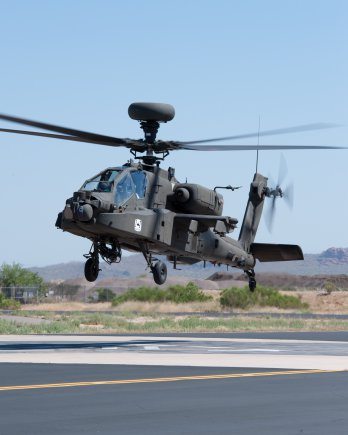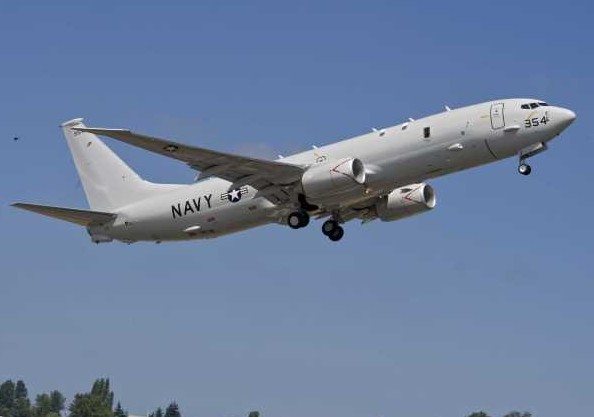The world’s most lethal attack helicopter just got even better. Inside a hangar against a backdrop of lights, fog, and looking as intimidating as ever, the first AH-64D Longbow Apache Block III was revealed to the public for the first time during a Roll Out ceremony Nov. 2 at the Boeing Apache production plant in Mesa, Ariz.
“Wow!” exclaimed Col. Shane Openshaw, project manager for Apache Helicopters. “To say that I’m proud would be a tremendous understatement. [Today] marks the completion of the first step of the journey to the future of the Apache. This first step took a tremendous amount of teamwork and is a reflection of great accomplishment with the combined efforts of this team.”
That teamwork was certainly reflected by the attendance of about 500 that included several dignitaries such as former vice chief of staff of the Army retired Gen. Dick Cody who flew the first AB3 prototype; retired Gen. Thomas Allen Schwartz, former U.S. Army Forces commander; various congressional representatives, other retired general officers, several international defense military representatives, current and former Apache project managers, and some members of the Boeing workforce.
“They’re here to say ‘Thank You’ to this entire team for your hard work and dedication to deliver this aircraft,” said Maj. Gen. Tim Crosby, program executive officer for Aviation. Directing his attention to the workforce, he added, “What we’re talking about today is the achievement of that vision (Army modernization). Every one of you that have worked on this aircraft is part of that success. Don’t take this lightly. You will save lives of our American Soldiers by what you have done. You have reduced the burden on that Soldier.”
Prior to the ceremony, a sacred blessing of the aircraft was performed by the White Mountain Apache Tribe led by Chairman Ronnie Lupe who is also a Korean War veteran, assisted by his executive officer Jerry Gloshay Jr. and spiritual leader Ramon Riley. The blessing was steep in Apache tradition that included a prayer, a ‘smudging’ of the aircraft, the singing of two songs and a final blessing. The semi-private ceremony was held on Boeing’s flight line at dawn with about 30 attendees.
The Apache Block III is the next evolution of the Army’s premier attack helicopter and is the only rotorcraft with the ability to operate at 6,000 feet and 95 degrees at an out-of-ground effect hover with a full mission payload.
The new Apaches will be stronger, faster and less constrained in extreme combat conditions, officials said. Along with the increase in top speed, it will turn faster and tighter, making it almost impossible for the enemy to hide, they said.
The new helicopter has a combat speed of approximately 164 knots, about 20 knots faster than those currently in service. The Block III aircraft brings back the performance of the early model and adds significant capabilities for [today’s] fight, officials said.
Some of the key upgrades to the Apache Block III include a more powerful engine and drive train, and composite rotor blades that provide more lift and will allow the aircraft to fly over any mountain in austere places like Afghanistan.
“The Block III brings back the power margins that crews had at roughly 3,000 or 4,000 pounds lighter gross weight than the Block II model,” said Lt. Col. Dan Bailey, Apache Block III product manager.
The aircraft had become heavier over the years when the Army added upgrades to the subsystems, making the pilot power margins more limited. “Now we’ll be able to go to all those places where the enemy tends to hide from us,” said Bailey.
Another key upgrade with the Apache Block III is its more advanced computer processing system called the Future Networked Force, which will ensure connectivity to the next generation of networked capabilities, making the aircraft viable and sustainable through the 2030/2040 timeframe. Bailey explained that when the Block II aircraft was built in the 1990s, it was based off of older computer technology.
The Block III’s open system architecture will allow the Army to put new subsystems onto the aircraft in a much more efficient manner which means it will be faster, less expensive to maintain, and more flexible to integrate any additional new technologies, Bailey said. As the pilots learn and as the environment changes, he said the Army can adapt the aircraft to whatever enemy force encountered.
“The Apache Block III is the leading edge today in terms of rotorcraft, and it’s the most advanced attack helicopter in the world. We want to maintain that, and the only way we can is by resetting the aircraft from an architecture perspective,” said Bailey.
The key enabler with the open system architecture is the ability of the Apache Block III to perform at Level 4 Interoperability with an unmanned aircraft system. This means that the pilot can now control the flight path, weapons systems and sensors on a UAS. “Only the Block III aircraft with its new computer processors and open architecture allows this to happen,” said Bailey.
Lt. Col. Edward Vedder, commander of the 1st Battalion, 1st Combat Aviation Brigade from Fort Riley, Kan., said he is extremely excited for his unit to be the first unit equipped with the Block III aircraft.
“This is a great capability that we’re going to be able to deliver to the battlefield,” said Vedder. “Right now somewhere far away, there’s a group of Soldiers at a combat outpost that are scared, they’re away from home, and we’re going to be able to provide that comfort to them because they know when that Apache comes over the horizon, everything is going to be okay.”
Training on the Apache Block III is scheduled to begin soon, and it will take some time to field the aircraft and train everyone in the unit. “But we have a great program laid out ahead of us in coordination with PEO Aviation, Operational Test Command and Fort Riley,” said Vedder. “They’re going to come and train our Soldiers there at Fort Riley so they’re going to be able to spend a little bit more time at home.”
During his keynote remarks, Maj. Gen. Anthony Crutchfield, commanding general for the Army Aviation Center of Excellence and Fort Rucker, reflected on his own experiences as an Apache pilot who departed for Iraq during Desert Shield/Desert Storm the day his son was born and was tasked to fly an aircraft that was not yet tested in battle.
“It was the A model Apache,” said Crutchfield, and enumerated its tremendous success on the battlefield. Following on that story and relating it to a more current war, Crutchfield talked about a group of Marines who heard the unmistakable sound of the Apache helicopter and knew that they were going to be all right. “You are the Boeing soldiers who help make that happen,” he said.
Already ahead of schedule, to date the Army has inducted 29 aircraft under the Apache Block III program. Fielding of the Block III Apaches to the first unit is slated to begin in 2012, and the Initial operational test is planned for Spring 2012. The first unit will be fully equipped with the new Apache Block III aircraft in fiscal year 2013. Currently, the Army is approved for 51 AB3 aircraft under the Low Rate Initial Production.
The Apache Block III is fundamentally a re-manufacture program, taking existing Longbow Apaches, inducting them, taking them apart, upgrading and refurbishing components, and adding the new Block III specific-capability insertions. The Army’s acquisition objective stands at 690 Apache Block III aircraft with 634 remanufactures and 56 new builds.











